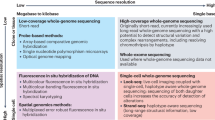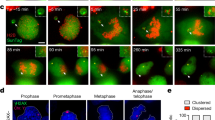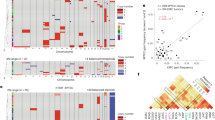Abstract
Recurrent chromosomal rearrangements are common in cancer cells and may be influenced by nonrandom positioning of recombination-prone genetic loci in the nucleus. However, the mechanism responsible for spatial proximity of specific loci is unknown. In this study, we use an 18 Mb region on 10q11.2–21 containing the RET gene and its recombination partners, the H4 and NCOA4 (ELE1) genes, as a model chromosomal region frequently involved in RET/PTC rearrangements in thyroid cancer. RET/PTC is particularly common in tumors from children exposed to ionizing radiation. Using fluorescence in situ hybridization and three-dimensional microscopy, the locations of five different loci in this region were mapped in interphase nuclei of normal human thyroid cells. We show that RET and NCOA4 are much closer to each other than expected based on their genomic separation. Modeling of chromosome folding in this region suggests the presence of chromosome coiling with coils of ∼8 Mb in length, which positions the RET gene close to both, the NCOA4 and H4, loci. There was no significant variation in gene proximity between adult and pediatric thyroid cells. This study provides evidence for large-scale chromosome folding of the 10q11.2–21 region that offers a structural basis for nonrandom positioning and spatial proximity of potentially recombinogenic intrachromosomal loci.
This is a preview of subscription content, access via your institution
Access options
Subscribe to this journal
Receive 50 print issues and online access
$259.00 per year
only $5.18 per issue
Buy this article
- Purchase on Springer Link
- Instant access to full article PDF
Prices may be subject to local taxes which are calculated during checkout




Similar content being viewed by others
References
Belmont AS, Bruce K . (1994). J Cell Biol 127: 287–302.
Bongarzone I, Butti MG, Coronelli S, Borrello MG, Santoro M, Mondellini P et al. (1994). Cancer Res 54: 2979–2985.
Ciampi R, Knauf JA, Kerler R, Gandhi M, Zhu Z, Nikiforova MN et al. (2005). J Clin Invest 115: 94–101.
Cornforth MN, Greulich-Bode KM, Loucas BD, Arsuaga J, Vazquez M, Sachs RK et al. (2002). J Cell Biol 159: 237–244.
Cremer C, Munkel C, Granzow M, Jauch A, Dietzel S, Eils R et al. (1996). Mutat Res 366: 97–116.
Cremer T, Cremer C . (2001). Nat Rev Genet 2: 292–301.
Futreal PA, Coin L, Marshall M, Down T, Hubbard T, Wooster R et al. (2004). Nat Rev Cancer 4: 177–183.
Grieco M, Santoro M, Berlingieri MT, Melillo RM, Donghi R, Bongarzone I et al. (1990). Cell 60: 557–563.
Kozubek S, Lukasova E, Ryznar L, Kozubek M, Liskova A, Govorun RD et al. (1997). Blood 89: 4537–4545.
Manton I . (1950). Biol Rev 25: 486–507.
Manuelidis L . (1990). Science 250: 1533–1540.
Manuelidis L, Chen TL . (1990). Cytometry 11: 8–25.
Munkel C, Eils R, Dietzel S, Zink D, Mehring C, Wedemann G et al. (1999). J Mol Biol 285: 1053–1065.
Nikiforov YE . (2002). Endocr Pathol 13: 3–16.
Nikiforova MN, Stringer JR, Blough R, Medvedovic M, Fagin JA, Nikiforov YE . (2000). Science 290: 138–141.
Ohnuki Y . (1965). Nature 208: 916–917.
Parada LA, McQueen PG, Munson PJ, Misteli T . (2002). Curr Biol 12: 1692–1697.
Rabes HM, Demidchik EP, Sidorow JD, Lengfelder E, Beimfohr C, Hoelzel D et al. (2000). Clin Cancer Res 6: 1093–1103.
Rattner JB, Lin CC . (1985). Cell 42: 291–296.
Roccato E, Bressan P, Sabatella G, Rumio C, Vizzotto L, Pierotti MA et al. (2005). Cancer Res 65: 2572–2576.
Roix JJ, McQueen PG, Munson PJ, Parada LA, Misteli T . (2003). Nat Genet 34: 287–291.
Ron E, Lubin JH, Shore RE, Mabuchi K, Modan B, Pottern LM et al. (1995). Radiat Res 141: 259–277.
Sachs RK, van den Engh G, Trask B, Yokota H, Hearst JE . (1995). Proc Natl Acad Sci USA 92: 2710–2714.
Santoro M, Dathan NA, Berlingieri MT, Bongarzone I, Paulin C, Grieco M et al. (1994). Oncogene 9: 509–516.
Shore RE . (1992). Radiat Res 131: 98–111.
Sumner AT . (1991). Chromosoma 100: 410–418.
Yokota H, van den Engh G, Hearst JE, Sachs RK, Trask BJ . (1995). J Cell Biol 130: 1239–1249.
Acknowledgements
We are grateful to H-UG Weier and JW Gray for providing PAC clone RMC10P016, to Ganesh Srinivasan and Bharath Arunachalam for technical assistance, and to Dave Campbell for assistance with creating the animation. Supported by NIH Grant CA88041.
Author information
Authors and Affiliations
Corresponding author
Additional information
Supplementary Information accompanies the paper on Oncogene website (http://www.nature.com/onc).
Rights and permissions
About this article
Cite this article
Gandhi, M., Medvedovic, M., Stringer, J. et al. Interphase chromosome folding determines spatial proximity of genes participating in carcinogenic RET/PTC rearrangements. Oncogene 25, 2360–2366 (2006). https://doi.org/10.1038/sj.onc.1209268
Received:
Revised:
Accepted:
Published:
Issue Date:
DOI: https://doi.org/10.1038/sj.onc.1209268
Keywords
This article is cited by
-
A comprehensive overview of the role of the RET proto-oncogene in thyroid carcinoma
Nature Reviews Endocrinology (2016)
-
Follicular cell-derived thyroid cancer
Nature Reviews Disease Primers (2015)
-
Tyrosine kinase gene rearrangements in epithelial malignancies
Nature Reviews Cancer (2013)
-
Molecular genetics and diagnosis of thyroid cancer
Nature Reviews Endocrinology (2011)
-
Triggers for genomic rearrangements: insights into genomic, cellular and environmental influences
Nature Reviews Genetics (2010)



